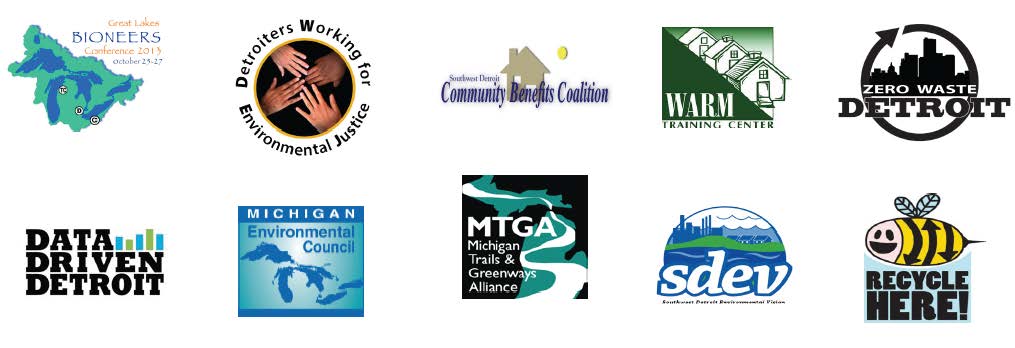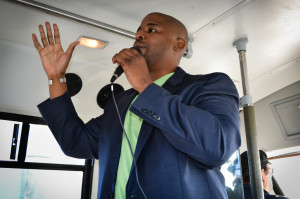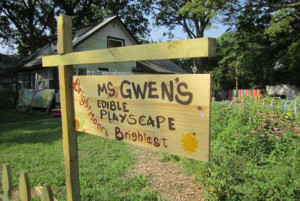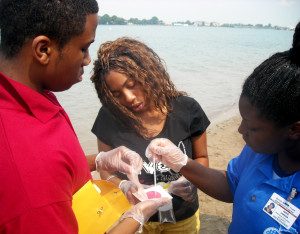Click here to view the full DEA Introduction 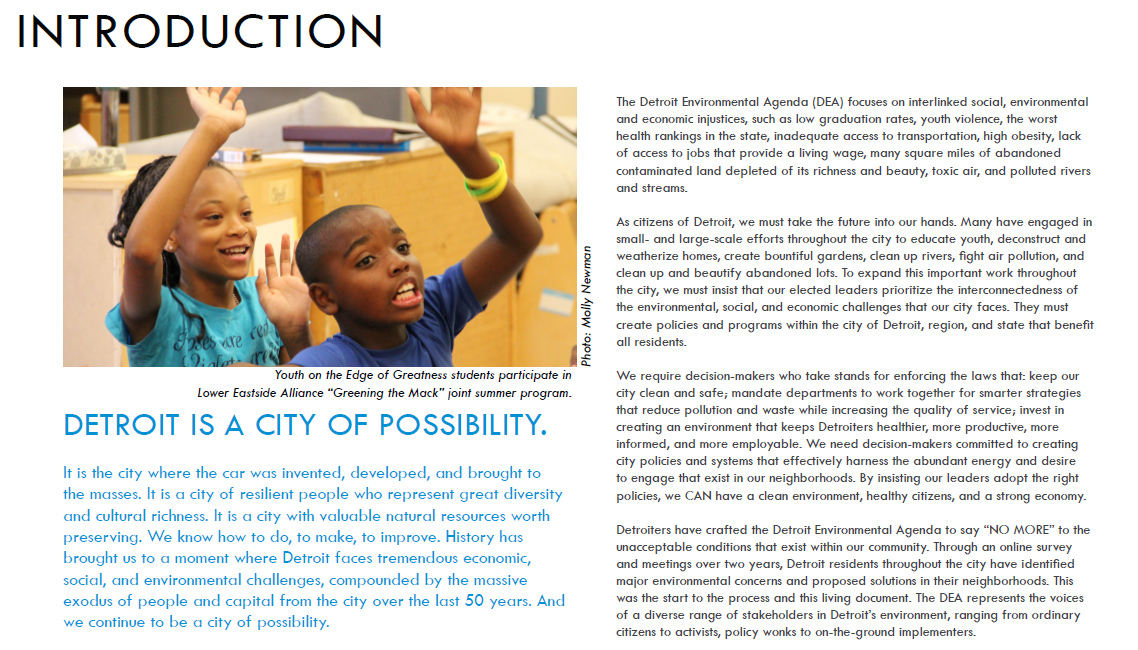
Detroit Environmental Agenda Steering Committee:
SEE FULL TEXT BELOW:
INTRODUCTION
Youth on the Edge of Greatness students participate in Lower Eastside Alliance “Greening the Mack” joint summer program.
Photo: Molly Newman
DETROIT IS A CITY OF POSSIBILITY.
It is the city where the car was invented, developed, and brought to the masses. It is a city of resilient people who represent great diversity and cultural richness. It is a city with valuable natural resources worth preserving. We know how to do, to make, to improve. History has brought us to a moment where Detroit faces tremendous economic, social, and environmental challenges, compounded by the massive exodus of people and capital from the city over the last 50 years. And continue to be a city of possibility.
The Detroit Environmental (DEA) focuses on interlinked social, environmental and economic injustices, such as low graduation rates, youth violence, the worst health rankings in the state, inadequate access to transportation, high obesity, lack of access to jobs that provide a living wage, many square miles of abandoned contaminated land depleted of it richness and beauty, toxic air, and polluted rivers and streams.
As citizens of Detroit, we must take the future into our hands. Many have engaged in small- and large-scale efforts throughout the city to educate youth, deconstruct and weatherize homes, create bountiful gardens, clean up rivers, fight air pollution, and clean up and beautify abandoned lots. To expand this important work throughout the city, we must insist that our elected leaders prioritize the interconnectedness of the environmental, social, and economic challenges that our city faces. They must create policies and programs within the city of Detroit, region, and state that benefit all residents.
We require decision-makers who take stands for enforcing the laws that: keep our city clean and safe; mandate departments to work together for smarter strategies that reduce pollution and waste while increasing the quality of service; invest in creating an environment that keeps Detroiters healthier, more productive, more informed, and more employable. We need decision-makers committed to creating city policies and systems that effectively harness the abundant energy and desire to engage that exist in our neighborhoods. By insisting our leaders adopt the right policies, we CAN have a clean environment, healthy citizens, and a strong economy.
Detroiters have crafted the Detroit Environmental Agenda to say “NO MORE” to the unacceptable conditions that exist within our community. Through an online survey and meetings over two years, Detroit residents throughout the city have identified major environmental concerns and proposed solutions in their neighborhoods. This was the start to the process and this living document. The DEA represents the voices of a diverse range of stakeholders in Detroit’s environment, ranging from ordinary citizens to activists, policy wonks to on-the-ground implementers.
Principles guiding the agenda:
– Ensure environmental justice: protect and involve vulnerable populations in decisions that impact their lives
– Protect and restore Earth’s resources: land, water, air
– Engage affected residents to understand community needs and potential impacts
– Leverage the connections between environmental solutions and health, safety, jobs, and education
– Build on successful models in Detroit and from elsewhere
The Detroit Environmental Agenda provides the tools for conversations that we must have with policy-makers, institutional and business leaders, not-for-profit organizations, and all citizens of the city of Detroit. As we near council by district and mayoral elections, candidates will be asked to respond to this Agenda through a questionnaire. We urge Detroit residents to push for its adoption and implementation once leaders are elected. The presence of the Emergency Manager demands that citizens use the strongest mechanisms of accountability to ensure that the acts of the EM help accomplish the goals. Similarly, the implementation of Detroit Future City requires active engagement so that the citizens and the environment of Detroit will benefit from this massive investment.
The DEA is organized so that the reader can read those sections of interest:
– In Section 1, we describe the purpose of the report, the community consultation that forms the basis of the report, and present the basic principles that undergird the overall project
– In Section 2, we provide an executive summary of our recommendations
– In Section 3, we connect priority issues such as public safety, city infrastructure, and economics to environmental factors
– In Section 4, we highlight opportunities in existing policy
– In Section 5, we describe three local policy initiatives, and highlight environmental opportunities in the revised City Charter and Detroit Future City Strategic Framework Plan
– In Section 6, we define commonly used environmental terms in a Glossary
Charles Stokes of Detroiters Working for Environmental Justice describes environmental challenges and assets on a citywide Toxic Tour.
Photo: Kirsten Ussery
Thank you for taking the time to read and engage with the Detroit environmental Agenda. We hope you see some of your efforts reflected in the document.
The DEA will give you information to talk with your family, your neighbors, your policy-makers and your leaders about the social, environmental, and economic well-being of Detroit. When we all work together, we create a better future.
We can do it.
PRINCIPLES
1. Ensure environmental justice: protect and involve vulnerable populations in decisions that impact their lives
2. Protect and restore Earth’s resources: land, water, air
3. Engage affected residents to understand community needs and potential impacts
4. Leverage the connections between environmental solutions and health, safety, jobs, and education
5. Build on successful models in Detroit and from elsewhere
Detroit must recognize the role a healthy environment plays in creating a city where people want to live, work, and raise a family.
First Image Above: Brightmoor Farmway (District 1) – Photo: Sandra Yu
Second Image Above: Detroiters Working for Environmental Justice youth monitor water quality at Belle Isle Beach (District 5) – Photo: Sandra Yu
Third Image Above: Recycle HERE! Holden location (District 5) – Photo: Matthew Naimi
Fourth Image Above: Milliken State Park at Detroit River (District 5) – Photo: AmericanForests.org
OUTREACH & ENGAGEMENT
480 Survey Responses
503 Reached through Community-hosted Meetings
303 Reached through DEA-hosted Meetings
The Detroit Environmental Agenda project originated from the 2011 Environmental Summit held to share resident and advocate concerns and ideas about the environment with City officials and the Detroit Works Project (now Detroit Future City). Feedback from that event has helped to shape the DEA principles and recommendations.
In community meetings and interviews in 2012, residents expressed a common desire for funding and assistance to implement green solutions in their own communities, such as solar lighting for parks, a deconstruction job training program, a tire-recycling company, a green industrial park, and green infrastructure projects.
They also wanted more information and education about environmental conditions, what individual actions they could take to remedy the problem, and how to access city departments for help in resolving the issues, including the appropriate authority and contact information. With land-based issues, residents were greatly interested in recent online interactive tools such as Data Driven Detroit’s tax auction map and Loveland Technologies’ parcel ownership and tax status map.
While some residents were interested in the details of city policies that could alleviate neighborhood environmental challenges, many more were concerned with seeing tangible improvements in their communities.
Source: Detroiters Working for Environmental Justice; Data Driven Detroit, Updated by DWEJ April 2013
SURVEY RESULTS
The Detroit Environmental Agenda distributed a public survey asking Detroit residents to rate the seriousness of various environmental challenges and solutions in their neighborhoods. Their responses were analyzed by district.
Surveys were distributed and collected in person at neighborhood and block club meetings, and online through community organizations’ e-newsletters and websites. We received a total of 480 responses, including 14 from nonresidents. District 1 had the highest number of responses (155), followed by District 6 (93). The fewest number of responses come from District 2 (28).
Respondents were asked to rate 33 different environmental challenges. The possible scores were grouped into “Serious” or “Medium” problem, “Minor” or “Not a problem,” or “I don’t know.”
The overall results were influenced by the high response rate from District 1, as well as our instructions to ask respondents to consider the various issues in their own neighborhood.
The top issues in each district were noted, and 11 issues appeared in at least 4 out of the 7 districts top 10 issues. 7 out of 7 districts rated Crime, Dangerous Structures, and Vacant Land Not Cared For as “Medium” or “Serious” problems. 6 out of 7 districts rate High Heating Bills and Litter as “Medium” or “Serious” problems. 4 out of 7 districts rated Hard to Get Places Without a Car, Illegal Dumping, Infrequent Buses, No Recycling, No Youth Activities, and Not Safe to Walk as “Medium” or “Serious” problems.
Based on the number of “I don’t know” responses in the survey, respondents were least aware of water and soil pollution, as well as the extent of environmental health impacts in their neighborhoods. (Respondents were most aware of transportation challenges and waste issues such as litter and the lack of convenient recycling.) The four issues with the highest number of “I don’t know” responses (out of 480 responses) were: fish contamination (154), lead poisoning (129), sewage in rivers (122), and polluted sites (101).
The diagram to the right shows the top 10 issues in each district, ranked by percentage of the district’s respondents who rated the issue as a “Medium” or “Serious” problem.
TOP ISSUES OF IMPORTANCE
Frequency of ranking in a district’s top 10 by percentage of “Medium” or “Serious” ratings
1. Crime (Districts 1, 2, 3, 4, 5, 6, 7)
2. Dangerous structures (1, 2, 3, 4, 5, 6, 7)
3. Vacant land not cared for (1, 2, 3, 4, 5, 6, 7)
4. High heating bills (1, 2, 3, 4, 5, 7)
5. Litter (1, 3, 4, 5, 6, 7)
6. Hard to get places without a car (1, 2, 4, 5)
7. Infrequent buses (1, 2, 5, 6)
8. Not safe to walk (1, 3, 5, 7)
9. Illegal dumping (2, 3, 4, 7)
10. No recycling (3, 5, 6, 7)
11. No youth activities (2, 3, 4, 5)
ISSUES OF LOWEST PUBLIC AWARENESS Frequency of “I don’t know” responses above 25%
1. Lead poisoning (1, 2, 3, 4, 5, 6, 7)
2. Contaminated fish (1, 2, 3, 4, 5, 6, 7)
3. Sewage in rivers, waterways (1, 2, 3, 5, 6)
4. Asthma (1, 2, 3, 4, 5)
5. Illegal or inappropriate business operations (1, 3, 6, 7)

